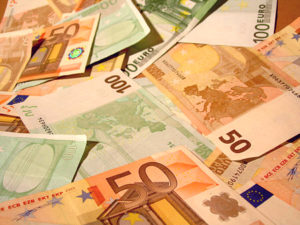 The euro extended its slide against the US dollar, as inflation in the euro area failed to accelerate towards ECBs target, which boosted speculation that central banks policy makers may have to cut interest rates at the upcoming meeting next week.
The euro extended its slide against the US dollar, as inflation in the euro area failed to accelerate towards ECBs target, which boosted speculation that central banks policy makers may have to cut interest rates at the upcoming meeting next week.
Having reached a session low at 1.3518 at 10:00 GMT, EUR/USD traded at 1.3532 at 12:43 GMT, losing 0.17% for the day. Yesterday the pair settled 0.75% lower, the biggest daily drop since January 2nd. Support was likely to be received at January 21st low, 1.3516, while resistance was to be encountered at January 30th high, 1.3662.
Eurostat reported today that consumer prices in the euro area rose at an annualized pace of 0.7% in January, after a 0.8% increase in the previous month. Analysts had estimated that consumer prices will increase by 0.9% in January. This was a fourth straight reading of inflation under 1%, while the ECB tries to maintain inflation at just below 2%.
Yesterday, a separate report revealed that the inflation in the largest economy in the euro zone, Germany, unexpectedly remained steady at 1.2% in January, defying analysts projections of an increase to 1.3%. The low German inflation just added to evidence of weak price pressure in the 18-nation common currency area.
In November, the central bank unexpectedly cut its benchmark interest rate to a record-low 0.25%, after inflation in the euro area slowed its pace to 0.7%. The European Central Banks policy makers are scheduled to next meet on February 6th.
However, “The ECB is unlikely to move its policy rates” or add “further accommodation via non-standard measures” next week, according to Annalisa Piazza, a fixed-income strategist at Newedge Group in London, cited by Bloomberg.
The weak inflation rate in the euro zone was mainly driven by a 1.2% slump in energy prices, todays report showed. Core consumer prices, which exclude volatile items such as energy, tobacco and alcohol, however, increased by 0.8% this month, after a 0.7% advance in December.
A separate report showed the unemployment rate in the euro area remained unchanged at 12% in December, after Novembers reading was downward revised to 12% from earlier estimates of 12.1%. The unemployment rate eased a bit from Septembers high of 12.1%..
Another bearish report pressured euros demand earlier in the week, as ECB said lending to companies and households contracted for a 20th consecutive month in December.
Meanwhile, the US Department of Commerce reported yesterday that consumer spending rose by 3.3% in the fourth quarter, marking the highest advance in three years. The data was preliminary and it came after a 2% increase in the previous quarter, while analysts had expected consumer spending will rise 3.7% in Q4. Consumer spending is regarded as a crucial economic indicator as it accounts for almost 70% of the total economy.
A separate report by the US Bureau of Economic Analysis revealed the preliminary gross domestic product of the country increased 3.2% in the fourth quarter, in line with analysts’ forecasts. The US economy expanded at 4.1% in the prior three months, which was the fastest pace since the first quarter of 2010.
However, data also revealed the number of initial jobless claims for the week ended January 25th, rose by 19 000 to 348 000, exceeding analysts’ estimates of an increase to 330 000. The number of jobless claims in the previous week was upward revised to 329 000 from earlier estimates of 326 000.
Greenback’s demand continued to be supported after the Federal Open Market Committee announced on Wednesday that it will reduce the pace of its monthly bond purchases to $65 billion from the current $75 billion. The FOMC cited improvements in the labor market and the pace of the economic growth, which started accelerating in recent quarters, in consonance with its plan to gradually withdraw from bank’s unprecedented accommodative policy. The central bank has undertaken three rounds of bond purchases since 2008, known as quantitative-easing stimulus strategy.
Elsewhere, having reached a session low at 102.33 at 05:00 GMT, USD/JPY traded at 102.56 GMT at 09:48 GMT, losing 0.16% for the day. Support was likely to be received at January 30th low, 102.09, while resistance was to be met at January 29th high, 103.36.





